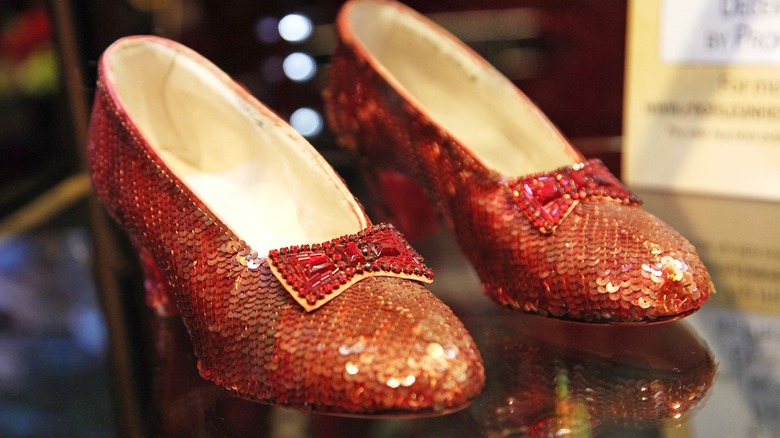How The Saga Of Judy Garland's Stolen Wizard Of Oz Shoes Finally Ended
The American film industry has produced a number of truly legendary movies, and the 1939 classic "The Wizard of Oz" is undoubtedly one of the all-time classics. While it had many visually interesting costumes, Dorothy Gale's sequined red shoes remain one of the most memorable pieces from the movie. Topped with a bow, the slippers possessed the magical power of transporting the wearer anywhere in the world. "There's no place like home," Dorothy memorably said while clicking her red heels three times, after which she woke up safely back home in Kansas.
Actor Judy Garland, who played Dorothy, wore numerous different pairs during filming. According to Morgan White, who directed "The Slippers," a documentary about the legendary shoes, it's unknown how many of them were actually made for the original project. Today, only a few have been accounted for.
"There are four known pairs in existence today, five if you count the Arabian test shoes that never made their way to the screen," White shared in a conversation with Glamour. One of the pairs was infamously taken from a museum in 2005 by a perpetrator who managed to hold on to them for over a decade. They were ultimately recovered by the FBI, finally ending the saga of Garland's stolen shoes for good.
The missing shoes were finally recovered in 2018
Judy Garland's iconic red slippers from the equally beloved "The Wizard of Oz" were recovered in 2018 after being stolen more than 10 years earlier from a museum in Minnesota, as the FBI announced at the time. In 2005, someone broke into the Judy Garland Museum (located within the late actor's childhood home in Grand Rapids) and took one of the most recognizable pairs of shoes in American history. There was no security footage or fingerprints at the scene, just a single red sequin. As the police had little to work with, a private donor offered a $1 million reward to anyone able to provide their whereabouts, per The New York Times.
After years of tips that led nowhere, a promising call came in 2017 from a person claiming to know where the ruby-red heels were. However, it turned out to be a cynical extortion attempt. A year-long undercover sting operation ensued, and the shoes were finally located. "Recovering a cultural item of this importance is significant. So many people of all ages around the world have seen 'The Wizard of Oz' and, in that way, have some connection to the slippers," FBI Special Agent Christopher Dudley noted.
Five years later, Terry Martin was "charged with one count of theft of major artwork," according to a press release from North Dakota's District Attorney's Office. The slippers' worth has more than tripled, valuing them at around $3.5 million in 2023.
How the iconic red pair came to be
In the original fairytale written by L. Frank Baum, "The Wonderful Wizard of Oz," Dorothy's shoes aren't actually red. In fact, they weren't even close to the shade, with Baum describing them as silver. The rest of the story pretty much goes down the same way as shown on screen, but the color of the shoes makes all the difference. Designed by MGM's chief costume designer, Gilbert Adrian, the heeled pumps are adorned with shiny red sequins and topped with matching butterfly-shaped bows.
According to Smithsonian magazine, the shade of Dorothy's slippers was changed for the movie because red was a better fit for the colorful world of Oz, including the legendary yellow brick road she needed to take to get to the Emerald City. Noel Langley, one of the film's screenwriters, came up with the idea, unknowingly making history in the process. Today, Dorothy's red shoes are considered the holy grail of Hollywood film history as well as a crucial part of "The Wizard of Oz" memorabilia for collectors.
An authentic pair of Garland's slippers can be viewed at the Smithsonian's National Museum of American History in Washington, D.C. Curator Dwight Blocker Bowers confirmed that the ruby slippers are always a visitor favorite. "It's the idea of 'there's no place like home' and that there is a warm place to cling to," he explained, adding, "It's a shared memory."

